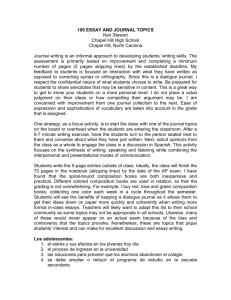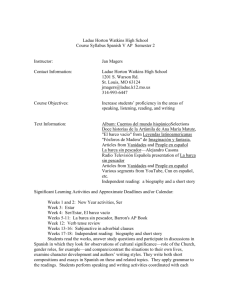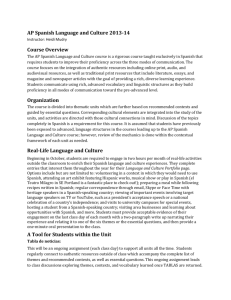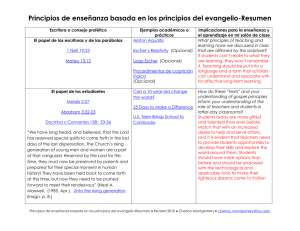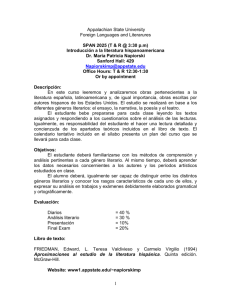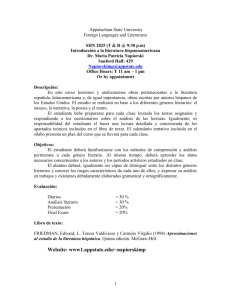Unit Three: Contemporary Life / La vida contemporánea
advertisement
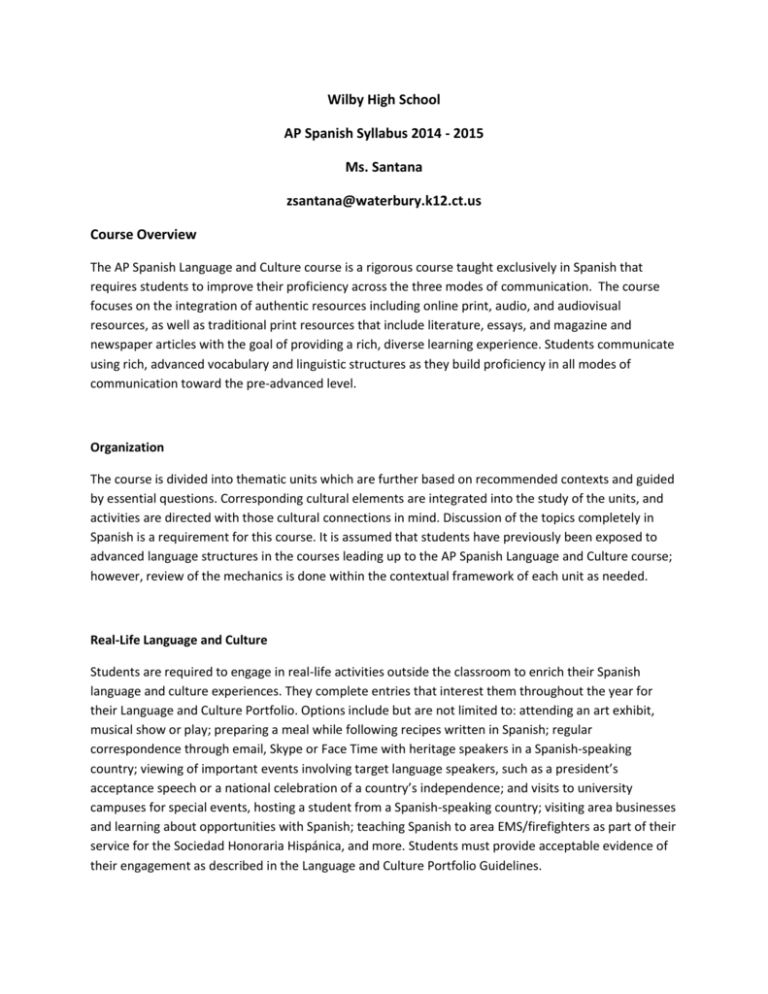
Wilby High School AP Spanish Syllabus 2014 - 2015 Ms. Santana zsantana@waterbury.k12.ct.us Course Overview The AP Spanish Language and Culture course is a rigorous course taught exclusively in Spanish that requires students to improve their proficiency across the three modes of communication. The course focuses on the integration of authentic resources including online print, audio, and audiovisual resources, as well as traditional print resources that include literature, essays, and magazine and newspaper articles with the goal of providing a rich, diverse learning experience. Students communicate using rich, advanced vocabulary and linguistic structures as they build proficiency in all modes of communication toward the pre-advanced level. Organization The course is divided into thematic units which are further based on recommended contexts and guided by essential questions. Corresponding cultural elements are integrated into the study of the units, and activities are directed with those cultural connections in mind. Discussion of the topics completely in Spanish is a requirement for this course. It is assumed that students have previously been exposed to advanced language structures in the courses leading up to the AP Spanish Language and Culture course; however, review of the mechanics is done within the contextual framework of each unit as needed. Real-Life Language and Culture Students are required to engage in real-life activities outside the classroom to enrich their Spanish language and culture experiences. They complete entries that interest them throughout the year for their Language and Culture Portfolio. Options include but are not limited to: attending an art exhibit, musical show or play; preparing a meal while following recipes written in Spanish; regular correspondence through email, Skype or Face Time with heritage speakers in a Spanish-speaking country; viewing of important events involving target language speakers, such as a president’s acceptance speech or a national celebration of a country’s independence; and visits to university campuses for special events, hosting a student from a Spanish-speaking country; visiting area businesses and learning about opportunities with Spanish; teaching Spanish to area EMS/firefighters as part of their service for the Sociedad Honoraria Hispánica, and more. Students must provide acceptable evidence of their engagement as described in the Language and Culture Portfolio Guidelines. Unit One: Global Challenges/Los Desafíos Mundiales Contexts Covered: • Economic Issues / Los temas económicos • Environmental Issues / Los temas del medio ambiente • Philosophical Thought and Religion / El pensamiento filosófico y la religión • Population and Demographics / La población y la demografía • Social Welfare / El bienestar social • Social Conscience / La conciencia social Essential Questions: • ¿Cuáles son los desafíos sociales, políticos y del medio ambiente que enfrentan las sociedades del mundo? •¿Cuáles son los orígenes de esos desafíos? • ¿Cuáles son algunas posibles soluciones a esos desafíos? Thematic Vocabulary: Spoken Interpersonal Communication As a class: Storyboard of vocabulary 1. The teacher places the following contexts on the white board and students go to the board to add vocabulary that would be needed to tell a story about the state of each category today: la economía, el medio ambiente, el pensamiento filosófico y lareligion, la población y la demografía, el bienestar social, la conciencia social. 2. The teacher adds additional key vocabulary explaining their meaning in context. 3. The teacher follows with a daily discussion on each topic using vocabulary from the board asking students personalized questions about each topic. Activate Prior Knowledge to Explore the Theme and Contexts: Spoken Interpersonal Communication VoiceThread with Peer Comments: 1. Students reflect on the following questions and give personal spoken responses using a picture, map, chart, or other graphic as evidence of their opinion: •¿Cuál desafío social, politico, o medioambiental es el más crítico para nuestro planeta? •¿Por qué piensas esto? •¿Cómo podríamos resolver este desafío? • ¿Qué te gustariá hacer personalmente para ayudar? 2. Peers access three VoiceThreads on which to comment and react to their classmates’ responses by questioning, commenting, analyzing, suggesting, inferring, and the like. Connecting to Authentic Resources: Audio, Visual, and Audiovisual Interpretive Communication, Written and Print Interpretive Communication (Spoken Interpersonal and Presentational Communication interwoven) 1. For homework, students listen to the following audio about the economic crisis in Spain and complete selected accompanying activities: http://audiria.com/capitulos- detalle.php?id=680. Class discussion the next day to answer: ¿Cuáles son los efectos de la crisis económica para la sociedad de España? Piensa en todos los apectos de la sociedad afectados. 2. The next evening, students read: El colombiano que lucha por salvar los corales www.bbc.co.uk/mundo/noticias/2012/10/121011_corales_jairo_rivera_am.shtml. Students should come to class prepared to discuss what Jairo Rivera Posada is accomplishing and why. 3. Using the Internet and consulting sites such as UNESCO and Radio Naciones Unidas, students explore the following themes and bring evidence to class for a circular discussion about why they are important and how they pose global challenges: • el pensamiento filosófico y la religion •la población y la demografía •el bienestar social Summative Assessment: Multimedia presentation Students choose one global challenge that interests them and prepare a Prezi or other multimedia presentation in which they depict the problem from the perspective of at least one Spanish-speaking country. They must include the essential questions: • ¿Cuáles son los desafíos sociales, políticos y del medio ambiente que enfrentan las sociedades del mundo? •¿Cuáles son los orígenes de esos desafíos? •¿Cuáles son algunas posibles soluciones a esos desafíos? Unit Two: La ciencia y la tecnología Contexts Included: • Access to Technology / El acceso a la tecnología • Effects of Technology on Self and Society / Los efectos de la tecnología en el individuo y en la sociedad • Health Care and Medicine / El cuidado de la salud y la medicina • Innovations / Las innovaciones tecnológicas • Natural Phenomena / Los fenómenos naturales • Science and Ethics / La ciencia y la ética Essential Questions: • ¿Qué impacto tiene el desarrollo científico y tecnológico en nuestras vidas? • ¿Qué factores han impulsado el desarrollo y la innovación en la ciencia y la tecnología? •¿Qué papel cumple la ética en los avances científicos? Thematic Vocabulary: 1. In groups of three, students write thematic vocabulary associated with science and technology. Words that are unfamiliar are defined by other students in Spanish. 2. The teacher selects one group to write the identified vocabulary on the white board. Each remaining group follows, only adding those not already listed. The teacher may also add additional vocabulary with which students may not already be familiar. 3. After a discussion, the class decides on a final list. Activate Prior Knowledge to Explore the Theme: Written and Spoken Interpersonal Communication 1. Reflection Log Entry: Students think about the following question and write personal responses in their logs: ¿Qué impacto tienen la tecnología y los avances científicosen mi vida personal? Then, through journal dialoguing, students engage in an exchange of ideas via a written format with another member of the class. This culminates in a full-class discussion on all of the individual perspectives of the students in the class. 2. Socratic circle to discuss and reflect on the following questions (students may, of course, add additional questions to the conversation): Spoken Interpersonal Communication • ¿Conoces a alguien que no use la tecnología o a quien no le importen los avances tecnológicos? Explica las circunstancias. •¿Cuáles han sido unos avances tecnológicos en el campo de la medicina? •¿Cómo ha afectado la tecnología los resultados y los efectos de los desastres naturales en los años recientes? •¿Cuál es la importancia de la ética con el uso de la teccnología para la investigación biomédica? Connecting to Authentic Resources: Audio, Visual, and Audiovisual Interpretive Communication, Written and Print Interpretive Communication 1. As a homework assignment, students access El genio que humanizó la tecnologíawhich discusses Steve Jobs from El País: http://tecnologia.elpais.com/tecnologia/2012/10/04/actualidad/1349377628_741832.html Lee el artículo y contesta: •¿Cómo humanizó Steve Jobs la tecnología? •¿Cómo te ha afectado la tecnología de Steve Jobs? 2. Read the text and watch the accompanying video to Tecnología para mejorar la calidad de la vida de los enfermos crónicos which discusses how computers improve the quality of life for the terminally ill, and write a brief summary of the main points to use during class discussion. 3. Listen and take notes from this audio from Radioteca: www.radioteca.net/result.php?id=06030015. Students respond to a multiple choice comprehension activity about the human genome and progress in the last ten years. Making Predictions: ¿Cuáles avances tecnológicos veremos en este siglo? • In pairs, students identify what they consider to be the greatest challenges in the modern world. • Using VoiceThread, students think about the conversation from class and answer the following question: ¿Cuál es un avance tecnológico que veremos este siglo para resolver uno de los problemas identificados? Differentiated Summative Assessment: Assessed using AP scoring guidelines keeping in mind that the focus of the assessment is the Essential Question: ¿Qué impacto tiene el desarrollo científico y tecnológico en nuestras vidas? Option one: Students interview someone in their lives who can speak in Spanish about his/her youth without cell phones, computers for creating texts, Internet for news, research, etc. This could be a teacher, a family member or friend, or a member of the local Spanish speaking community. Students compile a list of questions that they want to ask ahead of time and share them with other students for feedback and with the teacher if they still have any questions. The person interviewed will be able to give students a clear idea of how different life was. Then, students write an essay on how their lives would be different in both a positive and negative way if they did not have the technology today. Students will cite evidence from the interview and/or other information gathered. Option two: Students research hurricanes and tornados that occurred before the Internet Age and advances in technology. Then, they research technologies available for identifying and predicting tornadoes and hurricanes today. Finally, citing their sources, they write a persuasive essay telling how outcomes may have been different in those early natural disasters if they had the technology we have today, while citing evidence and synthesizing their research. Unit Three: Contemporary Life / La vida contemporánea Contexts Covered: • Education and Careers / La educación y las carreras profesionales • Lifestyles / Los estilos de vida • Entertainment and Leisure / El entretenimiento y el ocio • Traditions and social values / Las tradiciones y los valores sociales • Volunteer work / El trabajo voluntario • Relationships / Las relaciones personales Essential Questions: • ¿Cómo definen los individuos y las sociedades su propia calidad de vida? • ¿Cómo influyen los productos culturales, las prácticas y las perspectivas de la gente en la vida contemporánea? • ¿Cuáles son los desafíos de la vida contemporánea? Activate Prior Knowledge to Explore the Theme: Creative Written Presentational Task Homework Blog - Students reflect on the following situation and associated questions and write a short paragraph to respond: Imagina que tienes que crear una caja de tres tesoros para enviar a un pueblo extraterrestre para describir quiénes somos en el año 2015. ¿Cuáles tres productos incluirías? ¿Cómo describirías el producto y y la función que desempeña? ¿Cómo describirías la perspectiva que representa cada uno? ¿Cómo reflejan estos productos nuestra sociedad actual? Piensa cuidadosamente en los productos, prácticas y perspectivas que definen nuestravida contemporánea. After reading the blog entries, the teacher enables the “view by all” function so that students can read each other’s comments as another homework assignment. A Spoken Interpersonal discussion follows the next day. Connecting to Authentic Resources: Audio, Visual, and Audiovisual Interpretive Communication, Written and Print Interpretive Communication (Spoken Interpersonal and Presentational Communication interwoven) 1. Homework: students listen to the following audio from Más voces: www.masvoces. org/ReportajeDiade-la-Hispanidad-y • In class the next day, they answer the following questions: ¿Cómo influyen lasperspectivas de la gente en la celebración contemporánea de la fiesta el Día de la raza? ¿Debe España pedir perdón a los pueblos? ¿Cuáles son unos ejemplos de neo-colonialismo en la actualidad? • Students give their own opinions and cite examples. 2. Examinando algunas prácticas de la vida contemporánea: • In Abriendo paso: lectura, students read La Tomatina, complete the comprehension activities, prepare to answer and defend their opinions to the question, ¿Es diversion o tontería? • By accessing www.ver-taal.com/cultura_20080704_sanfermines.htm, students view and listen to: Los Sanfermines de Pamplona and complete the interactive activities that accompany the audiovisual presentation. Once again, they prepare to answer and defend their opinion: ¿Es diversion o tontería? 3. In class, students individually read the following news articles to learn about best careers for students in México, the U.S., and Argentina: www.informador.com.mx/economia/2010/252791/6/las-10profesiones-mejor-pagadas-de-mexico.htm www.lagaceta.com.ar/nota/480857/Tucumanos/Conoce-las-profesiones-mas-rentables-del-futuro.html • For homework, students research (in Spanish) the same information about the U.S. • In class the next day, they compare and contrast tendencies and predict why there may be differences. 4. Homework: Watch the following video about Carlos Slim Domit http://contenido.com.mx/seccion/videos/ • Research his work and answer the following question for class in paragraph form: ¿Por qué merece o no merece Domit ser otorgado el Premio Nacional de la Imagen Pública? • For an oral presentation: Compara a Carlos Slim Domit con Warren Buffett o Bill Gates por investigar información similar de sus carerras y empresas y por investigar sus actividades caritativas. • Students record presentations using Audio Dropbox from CLEAR 5. Homework for three evenings during which students must take notes to use as evidence in class, also citing statistics and information provided in graphic form. • Listen to the following audio about mothers working in Argentina: http://cadena3.com/contenido/2012/08/05/101209.asp • Read this article from Spain: http://elpais.com/diario/2010/11/14/sociedad/1289689201_850215.html • Read this report about the U.S.: http://imow.org/economica/stories/viewStory?language=es&storyId=4744 • In class discussion to answer the following questions, providing evidence from the three authentic resources above: • ¿Cómo ha cambiado el papel de la mujer en las tres sociedades? •¿Cuáles son las diferencias y semejanzas entre las estadísticas de las mujeres/ madres que trabajan fuera de la casa? •Como resultado, ¿cómo afectan estos cambios la vida contemporánea de la sociedad? • ¿Es posible que haya en el futuro una mujer tan exitosa como Carlos Slim Domit, Warren Buffett, o Bill Gates? Explica por qué. Redefining My Views: Written Presentational Communication Students prepare a persuasive essay to answer the following prompt: ¿Hasta qué punto se puede decir que la mujer y el hombre son iguales en nuestro mundo? Students read an article about advances women have made in recent times, hear an audio about the inequalities they still face, and look at a chart which compares earning by gender. In their essay, they should address at least one of the following essential questions, citing evidence from the unit: •¿Cómo definen los individuos y las sociedades su propia calidad de vida? •¿Cómo influyen los productos culturales, las prácticas y las perspectivas de la gente en la vida contemporánea? •¿Cuáles son los desafíos de la vida contemporánea? Unit Four: Las identidades personales y públicas Contexts Covered: • Alienation and Assimilation / La enajenación y la asimilación • Heroes and Historical Figures / Los héroes y los personajes históricos • National and Ethnic Identities / La identidad nacional y la identidad étnica • Personal Beliefs / Las creencias personales •Los intereses personales • Self-Image / La autoestima Essential Questions: •¿Cómo se expresan los distintos aspectos de la identidad en diversas situaciones? •¿Cómo se desarrolla la identidad de una persona a lo largo del tiempo? • ¿Cómo influyen la lengua y la cultura en la identidad de la persona? Connections also to the themes of: Los desafíos mundiales, La vida contemporánea, Las familias y las comunidades Activate Prior Knowledge to Explore the Theme: Spoken Interpersonal and Presentational Communication 1. Whole class: Discussion to explore this unit’s theme and recommended contexts based on questions such as: •¿Qué es un héroe? •¿Cómo describirían su identidad nacional? • ¿Es la identidad étnica tan importante como la identidad nacional? •¿Cuáles son sus creencias personales? ¿Cómo se formaron? 2. Think/Pair/Share Activity: Students think of an Hispanic hero in the U.S. and identify the contributions s/he has made for the well being of our society. After discussing in pairs, students share with the class as a whole. Explore Personal Beliefs About Self-image: Written Interpersonal communication; formative assessment Students write in a blog on the teacher’s website to answer the following questions: ¿Por qué es importante la autoestima de una persona? ¿Cómo afecta el destino de la persona? Students are required to engage in an extended written discussion with at least one of their classmates via the blog. Connecting to Authentic Resources: Audio, Visual, and Audiovisual Interpretive Communication, Written and Print Interpretive Communication 1. As a homework assignment, students access the following audio visual/written resource from BBCmundo.com (“EE.UU. y la educación: la batalla de una familia de inmigrantes”) to learn about problems that immigrant parents face helping their children with schoolwork and what this family defines as a new form of racism: www.bbc.co.uk/mundo/noticias/2011/09/110916_video_nuevo_mexico_cristian.shtml. To help guide the students, they first read over the following questions: • ¿Cómo te ayudaban tus padres con las tareas cuando estabas en la escuela primaria? •¿Cómo han participado tus padres en tus actividades escolares por los años? • ¿Es esta participación importante para tus padres y para ti? Explica tu respuesta. Students share out their responses to these questions in think-pair-share groups and are also encouraged to add their own opinions.After viewing the news report, students participate in an interactive conversation recording using Interactive Conversations through CLEAR, from Michigan State University: http://clear.msu.edu/teaching/online/ria/. This is then assessed using the AP World Language and Culture scoring guidelines for Spoken Interpersonal Communication. During class discussion the next day, they present reactions to these questions: • ¿Cómo es la autoestima de estos padres en este video con respecto a su habilidad de ayudar a su hijo a tener éxito en sus estudios? •Si fueras capaz de realizar cambios como oficial de la escuela, ¿qué harías para mejorar la situación de las familias que se encuentran en esta situación? 2. Students read and view the following news article and photos from el Nuevo Herald: www.elnuevoherald.com/2012/10/04/1314880/100-latinos-miami-recoge-historias. html, titled “100 Latinos Miami” recoge historias de superación y logros de cien hispanos. After reading the article, students write a reflective essay in which they draw conclusions as to how these immigrant Latinos have overcome diversity to reach success and how they can serve as role models for others facing problems such as alienation. As part of this assignment, students are asked to consider—what are the practices and perspectives that are highlighted in this piece? What do these successful Hispanics have in common? 3. Speaking Assessment: Students use the Internet to find authentic texts that explore challenges faced by immigrants to Spain. They use a T chart to document comparison of issues facing immigrants in the U.S. and should document sources so that they have them as evidence for Spoken Presentational communication: Desafíos en los EE.UU. Desafíos en España In class, students give an oral presentation in which they address the following prompt: Compara losdesafíos enfrentados por los inmigrantes a los EE.UU. con los inmigrantes a España. They are evaluated using AP scoring guidelines. Unit extension: Film: La misma luna (Discussion questions: How is the family unit affected when a parent goes to another country to find work to make a better life for the family? What are the risks? What unforeseen circumstances may arise to delay a family reunion?) Written Presentational Assessment: At the end of the unit, students write a culminating persuasive essay to answer the following prompt: ¿Debe uno asimilar la cultura o guardar su identidad cultural al inmigrar a un país nuevo? Students listen to an audio about the identity of the new generation of Hispanics in the U.S.: www.bbc.co.uk/mundo/cultura_sociedad/2010/06/100607_video_hispanos_generacion_la_np.shtml and read an article explaining how more than 60% of immigrant children living in Spain do not feel Spanish: www.eluniverso.com/2010/11/04/1/1360/mas-60-hijos-inmigrantes-identifican-comoespanoles.html?p=1360&m=1860 They also are given a map showing immigration patterns in various parts of Europe. The essay is evaluated using the new exam scoring guidelines. Students consider the unit essential questions as they develop the persuasive essay: •¿Cómo se expresan los distintos aspectos de la identidad en diversas situaciones? • ¿Cómo se desarrolla la identidad de una persona a lo largo del tiempo? • ¿Cómo influyen la lengua y la cultura en la identidad de la persona? Unit Five: Las familias y las Comunidades Contexts Included: • Customs and Values / Las tradiciones y los valores • Education Communities / Las comunidades educativas • Family Structure / La estructura de la familia • Global Citizenship / La ciudadanía global • Human Geography / La geografía humana • Social Networking / Las redes sociales Essential Questions: •¿Cómo se define la familia en distintas sociedades? • ¿Cómo contribuyen los individuos al bienestar de las comunidades? •¿Cuáles son las diferencias en los papeles que asumen las comunidades y las familias en las diferentes sociedades del mundo? Activate Prior Knowledge to Explore the Theme: Spoken Interpersonal Communication Whole class - Students think about the following questions and respond as fully as possible: 1. ¿Cómo se define una familia? 2. ¿Cómo adquiere una familia o una comunidad sus tradiciones y sus valores? 3. ¿Qué quiere decir la expresión “ciudadanía global”? 4. ¿Qué es una red social y para qué sirve? Connecting to Authentic Resources: Audio, Visual, and Audiovisual Interpretive Communication, Written and Print Interpretive Communication 1. Read online at La Nación: Las redes sociales cambiaron para siempre a América Latina www.nacion.com/2012-10-13/AldeaGlobal/las-redes-sociales-cambiaron-parasiempre-a-americalatina.aspx and be prepared to answer in class: ¿Cómo han cambiado las redes sociales para siempre a Latinoamérica? Da ejemplos. Compara el impacto de la redes sociales en los EE.UU. y en la América Latina, dando ejemplos específicos. 2. Assign this listening to the students, the idea of community and sharing of common goals: www.masvoces.org/Radio-logias-de-Economia-Social-y,4860 Using DropBox from CLEAR audio technologies, have students describe Can Cases (about 80 cooperative living community rule area of Catalunya) using a Who? What? Where? When? Why? format. 3. Cortometraje: La leyenda del espantapájaros Before viewing: A. Ask students to define the word leyenda and share legends that they know. B. Have students discuss why it is important to be part of a community, to have a feeling of belonging, and to have friends. C. Explore vocabulary (defined in Spanish) that students may not know while viewing, such as cobrar vida, malvado, and tiritear. D. View the YouTube video: www.youtube.com/watch?v=dn toIU1Ip5Vs E. follow up with Ricardo Arjona’s song, El espantapájaros www.youtube.com/watch?v=FKgLU7udUOM, which deals with a similar theme. To show understanding of the themes of both the song and video, students engage in a Written Presentational communication task in which they develop an essay based on the following questions: ¿Por qué existe el prejuicio? ¿Cuál es el mensaje de los dos productos? ¿Cómo puede la sociedad evitar actitudes similares y cambiar las prácticas y perspectivas que dirigen al prejuicio? Summative Assessment: Interpretive Print, Written and Spoken Presentational Communication 1. Students read about UNESCO and its goals and world initiatives and Spanish-speaking cultures, accessing their website: www.unesco.org/new/es/unesco/about-us/who-we-are/introducing-unesco/ As students explore the projects, organizations, and initiatives of UNESCO, they identify evidence that addresses these essential questions: ¿Cómo contribuyen los individuos al bienestar de las comunidades? ¿Cuáles son las diferencias en los papeles que asumen las comunidades y las familias en las diferentes sociedades del mundo? 2. Either individually or in pairs (decide year-by-year according to the make-up of the class), students created a multimedia presentation (Prezi, PowerPoint, Google presentation, or other) based on this resource to answer the following question: ¿Qué quiere decir ser ciudadano del mundo? Unit Six: La belleza y la estética Contexts Covered: • Architecture/ La arquitectura • Defining Beauty/ Definiciones de la belleza • Defining Creativity/ Definiciones de la creatividad • Fashion and Design/ La moda y el diseño • Language and Literature/ El lenguaje y la literature • Visual Arts/ Las artes visuals y escénicas Essential Questions: • ¿Cómo se establecen las percepciones de la belleza y la creatividad? • ¿Cómo influyen los ideales de la belleza y la estética en la vidaa cotidiana? • ¿Cómo las artes desafían y reflejan las perspectivas culturales? Activate Prior Knowledge to Explore the Theme: Interpersonal Speaking Whole Class: Students answer the following question: ¿En qué aspectos de la vida observamos la belleza? Thematic Vocabulary: 1. Distribute the handout below. 2. In groups of two, students brainstorm as many words and expressions as possible to use in discussing these contexts. La belleza humana La arquitectura El arte y la creatividad La moda y el diseño El lenguaje y la leteratura Las artes visuals y escénicas 3. Share orally with the group. ¿Es bello o no? 1. Using Poll Everywhere (www.polleverywhere.com/) create a poll where students will view examples of art, titles of literature with which they are familiar, architecture, photos of people, clothing, etc. to find out their perceptions of beauty. ¿Es bello? They can answer Sí o No. 2. Students volunteer to lead a short interpersonal discussion after each poll to stimulate thinking beyond the norm. Puntos de hablar-Comunicando por las artes: Spoken Interpersonal Communication Explain how we will discuss these points in contrast, answering student questions: • El realismo mágico del cuento Chac Mool, por Carlos Fuentes • El realismo del cuento Un día de estos, por Gabriel García Márquez •¿Cómo se define la diferencia entre la realidad y la fantasía? • El surrealismo y la fantasía de la pintura de Salvador Dalí, La persistencia de la memoria • El realismo histórico de la pintura: Sueño de una tarde domical en la alameda central, por Diego Rivera Connecting to Authentic Resources: Audio, Visual, and Audiovisual Interpretive Communication, Written and Print Interpretive Communication (Spoken Interpersonal and Presentational Communication interwoven) 1. Read for homework (divided in 2-3 evenings) Chac Mool, by Carlos Fuentes using www.ciudadseva.com/textos/cuentos/esp/fuentes/chac.htm • Provide pre-reading vocabulary that may be difficult. • Discuss the elements of realismo mágico. • Assign comprehension questions for each segment. • Have students also make connections to Mayan history and the importance of the figure of Chac Mool by researching authentic resources on the Web. • In class, besides answering the questions, discuss the realismo mágico of this story. • Discusión: ¿Por qué es esto un buen ejemplo del realismo mágico? 2. Listen to the story, Un día de estos, by García Márquez. Have students listen twice at home, providing a link to or downloading and posting: www.ivoox.com/un-dia-edit-gabriel-garcia-audiosmp3_rf_1196469_1.html • Provide pre-listening vocabulary that may be difficult. • Discuss elements of realismo in literature. • Assign comprehension questions to be answered in class. • In class, have students retell the story with ¿Quién? ¿Qué? ¿Dónde? ¿Cuándo? ¿Por qué? • Discusión: ¿Por qué es esto un ejemplo de realismo? 3. For homework, have students research one of the two paintings (equally dividing the class among the two): La persistencia de la memoria by Dalí and Sueño de una tarde domical en la alameda central by Diego Rivera. • Students analyze what they represent, bringing evidence to class, as well as a picture of it to use for presenting to a peer. • In class, students pair up and one presents his/her painting to the other, identifying important figures, stating what they represent, talking about style/genre, and giving one’s own opinion about how the painting affects him/her. Students may ask questions and develop conversations as they share presentations. 4. Have students research how Gaudí’s Sagrada Familia and other architecture was received during Gaudí’s time and how it is viewed today to answer the question: • ¿Cómo puede cambiar la percepción de la belleza por el tiempo? Bring the Unit to a Close: Summative Spoken Presentational Assessment evaluated with adapted AP scoring guidelines: Students create a cultural comparison using examples from their own culture and the culture of the Spanish-speaking world to address one of the following essential questions: • ¿Cómo se establecen las percepciones de la belleza y la creatividad? • ¿Cómo influyen los ideales de la belleza y la estética en la vida cotidiana? •¿Cómo las artes desafían y reflejan las perspectivas culturales?
